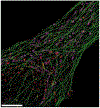Switchable Fluorophores for Single-Molecule Localization Microscopy
- PMID: 30221931
- PMCID: PMC6476321
- DOI: 10.1021/acs.chemrev.7b00767
Switchable Fluorophores for Single-Molecule Localization Microscopy
Abstract
The past decade has witnessed an explosion in the use of super-resolution fluorescence microscopy methods in biology and other fields. Single-molecule localization microscopy (SMLM) is one of the most widespread of these methods and owes its success in large part to the ability to control the on-off state of fluorophores through various chemical, photochemical, or binding-unbinding mechanisms. We provide here a comprehensive overview of switchable fluorophores in SMLM including a detailed review of all major classes of SMLM fluorophores, and we also address strategies for labeling specimens, considerations for multichannel and live-cell imaging, potential pitfalls, and areas for future development.
Figures











































References
-
- Abbe E Beiträge zur Theorie des Mikroskops und der mikroskopischen Wahrnehmung: I. Die Construction von Mikroskopen auf Grund der Theorie. Arch. Für Mikrosk. Anat. 1873, 9, 413–418.
-
- Hell SW Nobel Lecture: Nanoscopy with Freely Propagating Light. Rev. Mod. Phys. 2015, 87, 1169–1181.
-
- Moerner WE (William E . Nobel Lecture: Single-Molecule Spectroscopy, Imaging, and Photocontrol: Foundations for Super-Resolution Microscopy. Rev. Mod. Phys. 2015, 87, 1183–1212. - PubMed
-
- Betzig E Nobel Lecture: Single Molecules, Cells, and Super-Resolution Optics. Rev. Mod. Phys. 2015, 87, 1153–1168. - PubMed
-
- Hell SW Far-Field Optical Nanoscopy. Science 2007, 316, 1153–1158. - PubMed
Publication types
MeSH terms
Substances
Grants and funding
LinkOut - more resources
Full Text Sources
Other Literature Sources
Miscellaneous

